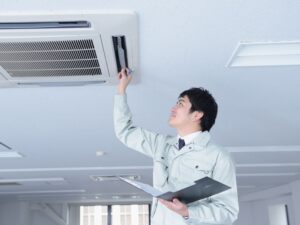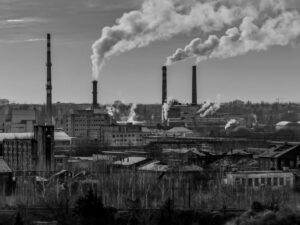
Apex Enviro’s Guide
As the last vestiges of South Africa’s glorious summer fade and the crisp bite of Autumn hints at the colder months ahead, a different kind of preparation should be top of mind for every responsible business. While we may not be bracing for White Walkers, the impending winter brings with it an often-overlooked, yet potentially devastating, threat: cold stress.
For many South African industries – from the sprawling fields of the Western Cape to the deep mines of Mpumalanga, the bustling cold storage facilities of Gauteng, and even those draughty warehouses across the nation – the dropping temperatures are more than just an inconvenience. They represent a significant occupational hazard that can severely impact employee health, productivity, and your organisation’s compliance standing with ventilation systems.
At Apex Environmental, we’re not just about monitoring; we’re about proactive protection. This timely guide will delve into why anticipating and mitigating cold stress risks is crucial as winter approaches, outlining your legal obligations and demonstrating how our expert cold stress assessment, including elements of ventilation assessment can ensure your workplace remains safe, productive, and fully compliant, even when the mercury plummets.
Beyond the Thermostat: Understanding Cold Stress in the South African Context
Cold stress isn’t merely about feeling chilly. It’s a physiological battle where the body loses heat faster than it can produce it, leading to a dangerous drop in core body temperature. While our climate might not boast Arctic extremes, the combination of factors prevalent in South African workplaces can quickly turn a cool day into a hazardous one with an extreme ventilation rate:
- Ambient Temperature: Obviously, the lower the temperature, the greater the risk. South Africa’s winter temperatures, particularly in the interior and high-altitude regions, can easily dip below 0°C, and even above-freezing temperatures can be dangerous when combined with other factors.
- Wind Chill: This is the silent assassin. Even a moderate breeze combined with cool temperatures can significantly increase the rate of heat loss. Think of the biting wind on a farm or the airflow in a large, unheated industrial shed. Our comprehensive ventilation assessment goes beyond simply measuring temperature; it analyses air movement to identify these hidden chill factors.
- Dampness and Wetness: Water conducts heat away from the body far more efficiently than air. Wet clothing, working in damp conditions (e.g., agricultural fields after rain, cold storage facilities with condensation), or sweating without proper moisture-wicking layers can accelerate heat loss dramatically.
- Physical Activity Levels: While strenuous work generates heat, it can also lead to sweating. If this moisture is not managed effectively with appropriate clothing, rapid cooling can occur once activity ceases, pushing workers into cold stress territory. Conversely, sedentary work in cold environments limits internal heat generation, making workers more susceptible.
- Duration of Exposure: Prolonged exposure, even to moderately cold temperatures, gradually depletes the body’s heat reserves.
- Individual Susceptibility: Age, pre-existing medical conditions (like diabetes, cardiovascular disease), medication, and even lifestyle choices can heighten an individual’s vulnerability to cold stress. One size does not fit all when it comes to thermal comfort.
Who’s at Risk? South Africa’s Vulnerable Workforces
The assumption that cold stress is only for those working in walk-in freezers is a dangerous myth. Many sectors across South Africa house workers susceptible to cold stress, especially during winter:
- Agriculture: Farmworkers, particularly during early morning harvests or pruning in winter, are directly exposed to ambient temperatures, wind, and often wet conditions.
- Mining: Both surface and underground operations can present cold environments, especially in open-cast mines in the cooler regions or deep shafts with specific ventilation patterns.
- Construction and Outdoor Maintenance: Road crews, utility workers, and construction teams are exposed to the elements, regardless of the weather.
- Logistics and Warehousing: Unheated or poorly insulated warehouses, distribution centres, and loading docks can become dangerously cold, especially with constant door openings.
- Food Processing and Cold Storage: These are the obvious culprits, with workers routinely operating in sub-zero temperatures. Strict controls and monitoring are paramount here.
- Manufacturing: Factories with large open bays, high ceilings, or significant air movement can expose workers to uncomfortable and potentially hazardous cold conditions.
- Emergency Services: Paramedics, police, and firefighters often operate in uncontrolled outdoor environments during emergencies, regardless of the weather.
The Chilling Impact: Why Proactive Management Matters
The consequences of cold stress extend far beyond a mere case of the shivers. They can significantly affect your workforce and your business:
- Health and Safety Risks: The most severe outcome is hypothermia, where core body temperature drops dangerously low, leading to confusion, loss of coordination, and potentially fatal cardiac arrest. Frostbite, chilblains, and trench foot are also serious concerns, often leading to permanent tissue damage. Less severe but equally impactful are increased susceptibility to respiratory infections and cardiovascular strain.
- Reduced Productivity and Efficiency: Even mild cold stress can impair dexterity, cognitive function, and concentration. Imagine a call centre agent with numb fingers struggling to type, or a factory worker making errors due to reduced alertness. Productivity inevitably dips, and the risk of accidents rises.
- Increased Absenteeism: Cold-related illnesses and injuries lead to more sick days, impacting staffing levels, increasing overtime costs, and disrupting operational flow. It’s a costly domino effect.
- Lowered Morale and Higher Turnover: No one wants to work in an uncomfortable or unsafe environment. A perception of inadequate care for employee well-being can lead to dissatisfaction, disengagement, and ultimately, a higher staff turnover rate.
- Legal Non-Compliance and Penalties: This is where things get serious for your bottom line and reputation.
Your Legal Compass: Navigating South African Cold Stress Regulations
South Africa’s Occupational Health and Safety Act (OHS Act), Act 85 of 1993, and the Physical Agents Regulations, 2024, clearly define an employer’s obligations regarding thermal environments. Ignorance is no defence when it comes to worker safety.
Key legal stipulations include:
- Duty to Provide a Safe Working Environment: The overarching principle is that employers must provide a working environment that is safe and without risk to the health of employees.
- Cold Stress Exposure Periods: For areas like cold storage, the regulations are even more prescriptive. They detail maximum continuous exposure times. This means you can’t just tough it out; you have to implement time restriction controls.
- Risk Assessments: Employers are legally obliged to conduct comprehensive risk assessments to identify hazards, including thermal stress, and implement appropriate control measures.
Non-compliance isn’t just a slap on the wrist. It can lead to hefty fines, directives from the Department of Employment and Labour, and even criminal prosecution in severe cases, tarnishing your company’s image and trust.
Apex Environmental: Your Partner in Cold Stress Mitigation
At Apex Environmental, we specialise in transforming potential hazards into safe and compliant working environments. Our approach to cold stress mitigation is holistic, leveraging our expertise as an Approved Inspection Authority (AIA) with SANAS accreditation to ISO/IEC 17020:2012. We don’t just offer generic advice; we provide tailored solutions based on rigorous data.
Our services for preparing your workplace for winter’s chill include:
Comprehensive Cold Stress Risk Assessments:
- Environmental Monitoring: Our qualified occupational hygienists utilise advanced, calibrated instrumentation (dry-bulb thermometers, anemometers for wind speed, humidity sensors) to precisely measure thermal environmental conditions at various workstations. We assess temperature, air velocity (a critical aspect for ventilation assessment to identify drafts and cold spots), radiant heat, and humidity.
- Workplace Analysis: We evaluate the nature of the work (light, moderate, heavy physical activity), the duration of exposure, work-rest cycles, and existing controls.
- Detailed Reporting: You receive an in-depth report outlining identified hazards, risk levels, and specific, actionable recommendations tailored to your unique operations.
Expert Recommendations for Control Measures:
- Engineering Controls:
- Heating Systems: Advising on appropriate and energy-efficient heating solutions for specific areas or general heating in break rooms.
- Insulation and Sealing: Recommending improvements to building insulation, sealing cracks, and draught-proofing to retain heat.
- Process Changes: Exploring options for automating tasks in extremely cold areas to minimise human exposure.
- Ventilation Optimisation: Our ventilation assessment capabilities are crucial here. We identify areas where excessive air movement (drafts) exacerbates cold stress and recommend solutions to control airflow without compromising essential ventilation for air quality. This includes evaluating existing HVAC systems for efficiency and identifying opportunities to recirculate warm air more effectively.
- Administrative Controls (Manage Exposure):
- Work-Rest Schedules and Job Rotation: Developing structured schedules that incorporate warm-up breaks in heated environments and rotating workers between cold and warmer tasks.
- Training and Awareness Programmes: Educating employees and supervisors on the signs and symptoms of cold stress, first aid, the importance of hydration, and proper layering. A little humour here: it’s not just about wearing a jersey; it’s about wearing the right jersey, and perhaps three others underneath!
- Provision of Warm Facilities: Ensuring accessible, warm break rooms with warm beverages.
- Personal Protective Equipment (PPE) Guidance:
- Layering Systems: Guiding on appropriate layering strategies using moisture-wicking base layers, insulating mid-layers (wool, fleece), and waterproof/windproof outer layers.
- Extremity Protection: Recommending suitable insulated gloves, hats, and waterproof footwear to protect hands, feet, and head where significant heat loss occurs.
Beyond the Chill: The Return On Investment of Proactive Cold Stress Management
Investing in cold stress mitigation is not an expense; it’s a strategic decision that yields significant returns:
- Enhanced Employee Well-being and Morale: A comfortable, safe workforce is a happy, engaged workforce. Show your employees you care, and they will reciprocate in loyalty and effort.
- Boosted Productivity and Reduced Errors: When employees are not battling the cold, their focus, dexterity, and cognitive function improve dramatically.
- Decreased Absenteeism and Healthcare Costs: Fewer cold-related illnesses mean fewer sick days, leading to better staffing and reduced medical expenses.
- Stronger Regulatory Compliance: Avoid penalties, legal hassles, and reputational damage by proactively meeting and exceeding OHS Act requirements.
- Improved Business Reputation: Demonstrate your commitment to a safe and healthy workplace, attracting and retaining top talent.
Don’t Get Caught Cold: Act Now
Winter is indeed coming, and the time to prepare your workplace for cold stress is now. Don’t wait for the first frostbite incident or a stern letter from the Department of Employment and Labour. Proactive measures are always more cost-effective and far less damaging than reactive crisis management.
Apex Environmental is your trusted partner in navigating the complexities of occupational health and safety. Our expertise in environmental monitoring, including critical ventilation assessment, empowers you to identify risks, implement effective controls, and ensure your workplace remains safe, productive, and compliant, even when the temperatures drop.
Contact Apex Environmental today for a comprehensive cold stress assessment and ensure your workplace is fully prepared to face the winter months. Let’s make sure your team stays warm, safe, and productive, no matter how low the mercury goes!








